Severe storm events in Sydney
Severe storm events in Sydney are not uncommon and would include hail storms, wind storms, and flash flooding from rain caused either by East coast lows (during autumn-winter periods) or ex-tropical cyclone remnants (during summer periods). East coast lows are low pressure depressions that can bring significant damage by heavy rain, cyclonic winds and huge swells. Sydney is rarely affected by cyclones, although remnants of ex-cyclones do affect the city.[1]
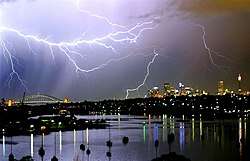
Scientists have predicted that rainfall in Sydney, with its moderate to low variability, will become more unpredictable and temperatures will be on the rise.[2][3] According to CSIRO and the Bureau of Meteorology, global warming has increased the chances of extreme rain and flash floods recently,[4] although destructive heavy rainfall events have occurred in Australia, including the Sydney area, since records began in the 18th century,[5] and ergo the chronological list below will showcase the notable storm events from the earliest recorded date until present.
Notable events
18th–19th century
- On 6 February 1788, Lieutenant Ralph Clark, an officer of the First Fleet, noted that he experienced "the most violent storm of lightning and rain", where he concludes, "The lightning was incessant during the whole night and I never heard it rain faster.”[6]
- The first recorded tornado in Australia struck Sydney in 1795, during the early settlement, where it destroyed crops and trees.[7]
- On 20 August 1857, the Dunbar, a sailing ship carrying 122 people from England, was wrecked off South Head while trying to seek shelter in Sydney Harbour, leaving only one survivor.[8]
- Both in June 1816 and June 1864, the Hawkesbury River had overflowed after heavy rainfall, rising over 14 meters, where it flooded, and caused widespread damage in, nearby towns.[9][10]
- On 22 June 1867, heavy rain and winds caused the water of the Hawkesbury River to rise to 19.2 metres, submerging and ruining 16,000 homes and buildings from Pitt Town to Wisemans Ferry. The flood caused 12 deaths, which were dramatically represented in the Illustrated Sydney News in July 1867. Survivors were on rooftops waiting to be rescued by boatmen.[10] Known as The Great Flood, it caused damage in the order of $1.4 billion in the Nepean region and it has about a one-in-280 chance of reoccurring again.[11]
- On 28 May 1889, the low-lying inner western suburbs of Croydon Park, Canterbury and Marrickville were heavily affected by torrential rainfall. Residents were depicted in newspapers in their rowboats rescuing the homeless and rowing through the flooded streets besides partially sunken shopfronts and homes.[10][12] Some suburbs, such as Prospect in the greater west, received 314.2 mm (12.4 in) of rainfall in 24 hours.[13]
20th century
1910s–1950s
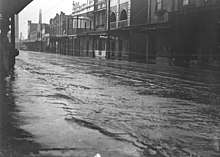
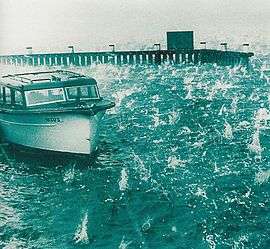
- On 26 November 1912, a powerful hail and thunderstorm passed over Sydney, where 12.7 mm (0.50 in) of rain fell in 10 minutes flooding streets, in addition to a lightning killing one labourer at a tramway construction site.[14]
- On 24 March 1914, Parramatta was flooded after 88.9 mm (3.50 in) of rain fell in just two hours. Parramatta railway station, business in Church Street and houses were partially submerged, and the Parramatta River was overflowed.[15]
- On 25 November 1914, a severe thunderstorm which was likely accompanying a tornado, hit Sydney’s northern and harbour-side suburbs, and destructed through a line of shopfronts near Lindfield railway station.[16]
- On 6 October 1916, an east coast low brought 120.1 mm (4.73 in) of rain in 24 hours, flooding roads, overflowing rivers and damaging vegetable gardens.[17]
- On 25 October 1919, a powerful hailstorm caused severe damage to buildings when it blocked gutters and drains, thus allowing rainwater to overspill into ceilings and basements.[16]
- On 6 July 1931, Sydney was whipped by cyclonic winds and heavy rainfall, where it received 198.1 mm (7.80 in) of rain in 24 hours. In addition to thousands of pounds worth of damage to property, which included roofs and electricity, five deaths were recorded.[18]
- On 25 January 1937, a tornado tore through the suburbs of Marrickville, Mascot, Botany and Matraville, where five people died and dozens were injured in falling buildings.[16]
- On 31 October 1940, a tornado created a 19 km (12 miles) path of damage, where it tore through thousands of homes, killing two people. A gust of 153 km/h was recorded.[16]
- In the 1947 Sydney hailstorm, which occurred on 1 January 1947, a storm cell developed on the morning of New Year's Day, over the Blue Mountains, hitting the city and dissipating east of Bondi in the mid-afternoon. At the time, it was the most severe storm to strike the city since recorded observations began in 1792. The high humidity, temperatures and weather patterns of Sydney increased the strength of the storm. The cost of damages from the storm were, at the time, approximately GB£750,000 (US$3 million); this is the equivalent of around A$45 million in modern figures. The supercell dropped hailstones larger than 8 centimetres (3.1 in) in diameter, with the most significant damage occurring in the central business district and eastern suburbs of Sydney.[19]
- On 15 June 1949, 94.1 mm (3.70 in) of rain fell in just one hour, the highest at that time since the records began. Flash flooding swamped businesses, shopfronts and homes.[20]
- In June 1950, a series of east coast cyclones develop off the New South Wales coast during which Sydney registered its highest monthly rainfall on record, 642.7 mm (25.3 in).[21][22]
- On 26 July 1952, Sydney CBD received 203.2 mm (8.00 in) of rain and cyclonic winds caused local floods, two landslides in the north, traffic delays and as well as a death of a man.[23]
- On 10 February 1956, heavy rain caused the Georges River to overflow, which led to five deaths, flooding 1,000 homes flooded and evacuation of 8,000 people. Homes in Bankstown, Panania, East Hills, Milperra, Moorebank and the surrounds were submerged. Stranded residents were rescued by the police, the army and by civilians in row boats.[16]
- On 9 July 1957, a tornado squall occurred at Warriewood and Narrabean in the Northern Beaches that blew off house roofs and caused more than £40,000 ($80,000) worth of damage.[16]
1970s–1990s
- On 24 April 1974, the western suburbs endured severe flash flooding that resulted in $20 million worth of damage and one death, as a consequence of 200 mm (7.87 in) of rain falling in three days.[16]
- On 10 March 1975, Sydney airport received 174.7 mm (6.88 in) of rainfall in six hours, in addition to flash flooding which caused more than $15 m worth of damage.[16]
- On 10 November 1976, intense thunderstorms caused severe damage in around Lidcombe and Auburn, with tennis-ball size (6 cm) hail and violent winds that injured 10 people. Damage costs were $40 million.[16]
- On 10–11 February 1978, a tornado tore through many homes in the Lower North Shore, injuring eight people. The damage cost was $15 million.[16]
- Between 19–24 March 1978, after an intense low pressure cell developed on the Coral Sea, travelling southwards, heavy rainfall occurred in the east coast which overflowed the Hawkesbury River, thereby flooding nearby homes and damaging roads. Several weather stations in the Sydney metropolitan area reported daily rainfall totals in excess of 250 mm (9.84 in).[24]
- On 8 November 1984, Sydney CBD saw 235 mm (9.25 in) of rain with 120.3 mm (4.74 in) falling at Observatory Hill in just one hour. Causing damage to homes in the Sydney Harbour and burying vehicles in mud, the storm was caused by a coastal trough with very high humidity values which in turn spawned very slow moving thunderstorms.[25] The cost of damages from the storm were, at the time, $80 million.[26]
- On 6 August 1986, a record 327.6 mm (12.90 in) of rainfall was dumped on the city in 24 hours, causing severe floods, major traffic problems and damage in many parts of the metropolitan area.[27]
- On 3 October 1986, ten people were injured and hundreds of homes were damaged after a hail up to 6 cm size hit the western suburbs. The total damage bill was $161 million.[25]
- On 3 February 1990, Sydney CBD received its record 24 hour February rainfall at 243.6 mm (9.59 in), when ex-tropical cyclone Nancy was centred on Brisbane.[28]
- On 18 March 1990, in around Auburn and Bankstown, large hail up to 8 cm diameter with strong winds and flash flooding caused $550 million worth of damage, where more than 2000 houses had window and roof damage.[29]
- On 21 January 1991, the Northern Sydney area (Turramurra, Pymble and the surrounds) received hail 7 cm in size with winds up to 230 km/h, and as well as 60 mm (2.36 in) of rain in 30 minutes. With a damage cost of $670 million, the storm event damaged over 7000 houses from felled trees and floods.[29]
- On 12 February 1992, in the western and northern suburbs, a storm caused $335 million worth of damage after rain, large hail and flash flooding battered over 500 houses.[29]
- On 20 November 1994, a severe storm caused $29 million worth of damage in the Sydney region, namely in the north, where many trees were felled and houses wrecked.[16]
- In the early hours of 30 August 1996, an east coast low ravaged Sydney, bringing destructive winds that damaged properties and heavy rainfall that caused flash flooding and road blockage. Turramurra received 160 mm (6.30 in) of rainfall in 24 hours, Epping at 143 mm (5.63 in) and the CBD at 127 mm (5.00 in). Wind gusts up to 160 km/h were recorded. Insurance payouts due to the storm were estimated to be up to $50 million.[30][31]
- On 7–8 August 1998, parts of Sydney and the Illawarra region received in excess of 300 mm (12 in) of rain over four days.[8]
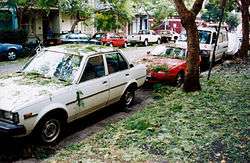
- The 14 April 1999 hailstorm was a notable storm event in Sydney, which caused severe damage in many suburbs and killed one man when his boat was struck by lightning. The storm produced hailstones of up to 9 cm (3.5 in) in diameter and resulted in insurance losses of around A$1.7 billion in less than five hours.[32]
21st century
2000s–2010s
- On 3 December 2001, the state of New South Wales recorded a wind gust of 174 km/h during a freak thunderstorm in Richmond. In addition, two schoolchildren were killed after a tree fell on their tent in the northern suburbs.[16]
- On 8 January 2003, a powerful southerly buster brought a maximum wind gust of 109 km/h, as well as a lightning storm with small hail that caused blackouts in over 70 suburbs.[16]
- Between 1 and 2 February 2005, a powerful East Coast Low caused flash flooding in Sydney with reports of 6 cm size hail, in addition to roofs being blown off in Gladesville.[16]
- A major storm in early June 2007 brought over 500 mm (19.69 in) of rainfall in 5 days in the Sydney CBD and the eastern suburbs.[33][34]
- On 9 December 2007, a powerful thunderstorm affected western Sydney with hail 7 cm in diameter. The State Emergency Service received over 6000 calls for assistance and the damage bill was $201 million.[16]
- In February 2010, Sydney received some of the highest rainfalls in 25 years with 65 mm (2.6 in) of rain falling in one night at Observatory Hill. In the first weeks of the month, some suburbs were hit by thunderstorms which brought heavy rain and gusty winds which cut out power and damaged homes.[35][36][37] The heavy rain was caused by remnants of ex-tropical Cyclone Olga and humid north-easterly winds feeding into the low pressure trough.[38][39] 2010 was an overly wet year with the cloudiest October and the third cloudiest July on record.
- In 2011, Sydney recorded its wettest July since 1950. The CBD recorded 244 mm (9.61 in) of rain that month. 2011 was also the wettest year since records began in 1858.[40]
- On 18 November 2013, an EF1 tornado hit Hornsby, a suburb in the Upper North Shore, where winds reached 140 kilometres per hour (87 mph).[41] The tornado's path was 2 km (1.2 mi) long and 50 m (160 ft) wide.[42][43] Blowing off roofs and toppling large trees, the tornado injured a total of 12 people.[41]
- On 15 October 2014, a rainstorm described as a "once-in-a-decade event" hit the Sydney region. Parts of Sydney received the heaviest amount of rain in a span of hours in decades. 94 mm (3.70 in) of rain fell in Strathfield in just over three hours. The winds were cyclonic in nature, with Sydney Airport having over 107 km/h (66 mph) gusts, reaching Category 1 strength. This event happened due to the formation of an east coast low, which ignited several other low pressure systems.[44]
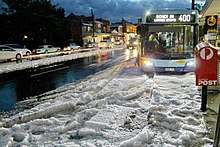
- On 20 April 2015, Sydney recorded 119.4 mm (4.70 in) of rainfall, the most in any day since February 2002. Winds were "cyclonic" in nature, reaching 135 km/h (84 mph). Killing three people, this east coast low was formed with "a really pronounced upper level trough of cold air that had moved in from Victoria", Mr Sharpe said.[46] The maximum temperature was only 15.4 °C (60 °F), making it the coldest April day since 1983, according to BOM.[47]
- In the afternoon of 25 April 2015, on Anzac Day, small hail measuring between one and two centimetres blanketed parts of Sydney, turning streets white whilst damaging homes, factories and cars, with the inner west suburbs of Surry Hills and Ultimo being the worst hit, as well as the North Shore and the eastern suburbs, which also received flash flooding. Caused by a cold system which formed over the South West Slopes and the Blue Mountains, the hailstorm was very immense, reaching knee height, where locals made snow angels, snowmen and even skated on it.[48]
- On 5 June 2016, an east coast low brought heavy rainfall that passed the average total June rainfall of 132 mm (5.20 in). The deluge led to flash floods across the city and caused coastal erosion, in addition to five deaths being reported. Bankstown received its highest daily rainfall in 15 years, with 141 mm (5.55 in) of rain within the 24 hours. Meanwhile, Pennant Hills, Sydney Airport and Prospect Reservoir experienced their wettest June day since 1991.[49]
- On 28 November 2018, a number of suburbs in the Sydney CBD recorded over 100 mm (3.94 in) of rainfall in just two hours from thunderstorms that formed due to an intense low pressure system, which came from the west, in what's been the city's wettest November day since 1984.[50] The heavy deluge caused flash flooding, submerging cars in the suburb of Redfern, alongside wind gusts that peaked over 90 km/h, which brought down trees and also contributed to the deaths of two people.[51] In Mosman on the North Shore 111 mm (4.37 in) of rain fell by 9am, making it the wettest spot in Sydney that day.[52]
- On 20 December 2018, after a hot sultry day, a fast-moving storm coming from the southwest dumped hail stones the size of coins in Sydney just after 4:30pm. The Bureau of Meteorology warned of “giant hailstones”, detecting "very dangerous thunderstorms".[53] Two centimetre hailstones were reported at Petersham, Summer Hill three centimetres and Berowra reported hailstones that were five centimetres in diameter, which caused extensive roof and skylight damage, and power outage in over 2,000 homes. Due to the intensity of the hailstorm, Town Hall Station in the Sydney CBD was closed, flights were delayed, and 2,000 homes in Epping and Carlingford lost power. Furthermore, hailstones as large as tennis balls were reported, and photographed, by residents on social media in Sydney's southwest.[54]
- On 9 January 2019, Sydney was hit by a lightning storm that was "one of the biggest in recent years", where several houses were stuck. Blacktown was the worst affected by the lightning storm, with over 20 homes reported roof damage.[55]
- On 8 February 2019, intense thunderstorms, lightning and heavy rain caused significant damage to buildings, severe road flooding, which left 45,000 homes across Sydney without power. About 50 mm (1.97 in) fell in some inland suburbs in a span of just 30 minutes. Such heavy rainfall in a short period of time is expected once every ten years in the metropolitan area.[56]
2020s–present
- Between 7 and 9 February 2020, the Sydney metropolitan area received its heaviest rain in 30 years due to an east coast low (which is unusual in the summer). The storm brought vast flooding and strong winds that caused commuter chaos and left over 20,000 homes without power.[57] The city recorded around 391.6 mm (15.42 in) of rain within those three days, more than three times the average rainfall for February. Thousands of people living in depressed areas, such as those in Narrabeen and southwest of Sydney near Georges River, were told to evacuate due to billowing floodwaters and rising river levels. At least 200 people were rescued by emergency services during the stormy weekend. Warragamba Dam, which was only at 42% in capacity, reached as close to 70% after the deluge.[58][59] The last time more than 300 mm (11.81 in) of rain fell in two days in the city was in 1992, in addition to being the wettest four-day period since 1990.[60]
- In the late evening of 18 February 2020, over 60,000 lightning strikes hit the Sydney area,[61] with wind gust over 100 km/h (62 mph) being recorded in some Sydney suburbs. In addition to a man being killed by a flying gas cylinder in The Rocks, the storm toppled trees, damaged properties and left tens of thousands of homes without power.[62]
Precipitation and sun data
Despite its susceptibility to heavy rainfall events, Sydney is fairly sunny, receiving around 109 clear days and 2635 hours of sunshine, annually.[63][64] Even in its months of highest rainfall Sydney has relatively few rainy days, with less than 10 wet days per month on average, on the 1 mm (0.04 in) threshold, with fewer rain days and precipitation amount recorded inland.[65]
Climate data for Sydney (Observatory Hill) | |||||||||||||
|---|---|---|---|---|---|---|---|---|---|---|---|---|---|
| Month | Jan | Feb | Mar | Apr | May | Jun | Jul | Aug | Sep | Oct | Nov | Dec | Year |
| Average rainfall mm (inches) | 91.1 (3.59) |
131.5 (5.18) |
117.5 (4.63) |
117.1 (4.61) |
100.2 (3.94) |
144.7 (5.70) |
76.8 (3.02) |
75.4 (2.97) |
63.4 (2.50) |
67.7 (2.67) |
90.6 (3.57) |
73.0 (2.87) |
1,150.1 (45.28) |
| Average rainy days (≥ 1 mm) | 8.2 | 9.0 | 10.1 | 8.1 | 7.8 | 9.2 | 7.1 | 5.6 | 5.8 | 7.6 | 8.7 | 7.9 | 95.1 |
| Mean monthly sunshine hours | 235.6 | 202.4 | 213.9 | 207.0 | 195.3 | 177.0 | 204.6 | 244.9 | 237.0 | 244.9 | 228.0 | 244.9 | 2,635.5 |
| Source 1: Bureau of Meteorology[66][67] (1991–2020 averages, records 1861–) | |||||||||||||
| Source 2: Bureau of Meteorology, Sydney Airport (sunshine hours)[64] | |||||||||||||
| Climate data for Prospect Reservoir (Western Sydney) | |||||||||||||
|---|---|---|---|---|---|---|---|---|---|---|---|---|---|
| Month | Jan | Feb | Mar | Apr | May | Jun | Jul | Aug | Sep | Oct | Nov | Dec | Year |
| Average precipitation mm (inches) | 96.2 (3.79) |
95.9 (3.78) |
96.2 (3.79) |
76.7 (3.02) |
70.8 (2.79) |
75.4 (2.97) |
56.1 (2.21) |
50.2 (1.98) |
46.4 (1.83) |
58.7 (2.31) |
73.6 (2.90) |
75.9 (2.99) |
874.0 (34.41) |
| Average precipitation days (≥ 1mm) | 8.0 | 8.2 | 8.4 | 7.0 | 6.3 | 7.0 | 5.6 | 5.7 | 6.1 | 6.8 | 7.3 | 7.5 | 83.9 |
| Source: [68] | |||||||||||||
See also
- Severe storms in Australia
- Southerly buster
- Climate of Sydney
References
- Tropical Cyclones in New South Wales
- < "Weather & climate". Retrieved 25 December 2014.
- East Coast Lows
- "Forecasters warn of potentially 'life-threatening flash-flooding' in Sydney". Retrieved 29 May 2020.
- Nicholls, Neville (2020-02-10). "Fires and floods: Australia already seesaws between climate extremes – and there's more to come". The Guardian. Retrieved 2020-05-29.
- WEATHER SECRETS OF THE FIRST FLEET VOYAGE Arthur Phillip Chapter of Fellowship of First Fleeters
- Evershed, Nick (2013-03-26). "MULTIMEDIA: Tornadoes in Australia". The Courier. Retrieved 2014-01-22.
- "When were most recent major East Coast Lows?". Bureau of Meteorology. Retrieved 6 April 2013.
- La Niña brings flooding rains to NSW in the early 1860s by Climate History Australia, September 27, 2012. 16 April 2020
- Sydney’s wild weather by Nicole Cama, June 9, 2016. Retrieved 14 April 2020
- Sydney’s most devastating flood, the Great Flood of 1867, remembered by The Daily Telegraph, June 21, 2017. Retrieved 15 April 2020
- The Sydney Morning Herald (NSW : 1842 - 1954) by Trove (National Library of Australia). Retrieved 14 April 2020
- "Climate statistics for Prospect Reservoir". Bureau of Meteorology. Retrieved 14 April 2020.
- Flood in Sydney Townsville Daily Bulletin (Qld: 1907 - 1954). Retrieved 15 April 2020
- PARRAMATTA FLOODED. BUILDINGS DESTROYED. MANY EXCITING EXPERIENCES. Tue 24 Mar 1914. Sydney Morning Herald (NSW: 1842 - 1954)
- Stormy weather - A century of storms, fire, flood and drought in New South Wales by the Bureau of Meteorology, 2009. Retrieved 15 April 2020
- THE FLOODS. SYDNEY- DOWNPOUR. Remarkable Rain Records. The Argus (Melbourne, Vic. : 1848 - 1957). Retrieved 15 April 2020
- SYDNEY LASHED BY STORM by The Daily News (Perth) from The National Library of Australia. Retrieved 15 April 2020
- "ICE STORM LASHES CITY AND SUBURBS". The Sydney Morning Herald (34, 018). New South Wales, Australia. 2 January 1947. p. 1. Retrieved 11 September 2016 – via National Library of Australia.
"SCENES OF DEVASTATION AFTER FREAK HAIL HIT CITY". The Sydney Morning Herald (34, 018). New South Wales, Australia. 2 January 1947. p. 1. Retrieved 11 September 2016 – via National Library of Australia. - SYDNEY HAS WORST FLOOD IN HISTORY Townsville Daily Bulletin (Qld.:1907 - 1954). Retrieved 15 April 2020
- "Australian East Coast Storm 2007: Impact of East Coast Lows". Guy Carpenter. October 2007. Retrieved 7 April 2013.
- Hopkins, Linda C.; Holland, Greg J. (1997). <0621:AHRDAA>2.0.CO;2 "Australian Heavy-Rain Days and Associated East Coast Cyclones: 1958–92". Journal of Climate. 10 (4): 621–635. Bibcode:1997JCli...10..621H. doi:10.1175/1520-0442(1997)010<0621:AHRDAA>2.0.CO;2.
- DEATH. FLOOD DAMAGE AND DELAYS IN SYDNEY STORM|TWO LANDSLIDES BLOCK. MAIN NORTHERN RAILWAY The Sun (Sydney, NSW : 1910 - 1954). Retrieved 15 April 2020
- The March, 1978 flood on theHawkesbury and Nepean Riverbetween Penrith and Pitt Town S. J. Riley, School of Earth Sciences, Macquarie University, North Ryde. Retrieved 15 April 2020
- "Bureau - Severe Storm events - 1980/1989". pandora.nla.gov.au. Archived from the original on 11 March 2012. Retrieved 24 May 2019.
- Sydney, New South Wales, November 1984 Flood - Sydney Australian Institute for Disaster Resilience. Retrieved 15 April 2020
- Rain in Sydney, 1986 in Australian Climate Extremes, Bureau of Meteorology. Retrieved 9 September 2006.
- Low pressure systems off the New South Wales coast and associated hazardous weather: establishment of a database by Milton S. Speer, Perry Wiles and Acacia Pepler, Climate Change Research Centre, Faculty of Science, The University of New South Wales, Sydney, Australia. Bureau of Meteorology, Department of Physical Geography, Macquarie University, Sydney, Australia
- The response to the ‘mother of all storms’: a combat agency view By Chas Keys, Deputy Director General, NSW State Emergency Service. Retrieved 15 April 2020
- East Coast Low: Saturday 31st August 1996 by Michael Bath
- Wet-weather flashback: Round 22, 1996 by Zachary Gates, 10 February 2020. Retrieved 21 February 2020.
- "The Sydney Hailstorm - 14 April 1999". Bureau of Meteorology. Retrieved 5 October 2006.
- "Summary of Significant Severe Thunderstorm Events in NSW - 2007/08". Bureau of Meteorology. 2011. Archived from the original on 4 June 2011. Retrieved 27 September 2011.
- Sydney has wettest June for 57 years
- "Storm drenches Sydney". UPI.com. 12 February 2010. Retrieved 1 June 2010.
- "Sydney dries out but regional threatened". News.smh.com.au. 12 February 2010. Retrieved 1 June 2010.
- "Weather News - Wild storms lash Sydney". Weatherzone.com.au. 13 February 2010. Retrieved 1 June 2010.
- "Rain swamps Sydney's water catchments". Smh.com.au. 7 February 2010. Retrieved 1 June 2010.
- Huffer, Julie (10 February 2010). "Heaviest rain in almost 20 years - Environment". Hornsby-advocate.whereilive.com.au. Archived from the original on 20 January 2013. Retrieved 1 June 2010.
- Sydney records its wettest July in 50 years as parts of NSW are declared disaster zones
- Hornsby hit by mini tornado which sounded like a freight train and ripped the roof of the Myer building
- Clean-up continues after tornado strikes at Hornsby in Sydney's north
- "Hornsby was hit by a tornado, Bureau of Meteorology confirms". The Sydney Morning Herald.
- "'Once every 100 years': what made the Sydney storm so ferocious". The Sydney Morning Herald. 15 October 2014.
- Roads turn to rivers as NSW suffers freak hailstorm by The Daily Telegraph
- Sydney weather: It's not a cyclone but it sure felt like one
- NSW wild weather: Three killed, homes washed away in Dungog as 'cyclonic' winds batter Sydney, Hunter and Central Coast
- Sydney hail storm: Your pictures show hail blanketing city and Blue Mountains by ABC News
- Rain records broken across Sydney by Sarah Muller, from The Sydney Morning Herald, June 5, 2016
- Sydney weather and Queensland bushfire extremes have a common thread by Kate Doyle (ABC News Australia)
- Two dead as heavy rain and storms cause commuter chaos in Sydney By Rachel Clun, Sarah Keoghan & Jenny Noyes (Sydney Morning Herald)
- Wild Wednesday: SES volunteer dies as torrential rain lashes Sydney and surrounds by Benedict Brook, Charlotte Willis and Rohan Smith (news.com.au)
- Huge hailstones batter parts of Sydney as a severe storm sweeps through by Bellinda Kontominas (ABC News Australia)
- Sydney storm: Hail hits as city braces for more wild weather by Sascha O’Sullivan and Adrian McMurray The Australian
- Sydney hit by fierce lightning storm but hot weather forecast to return to the city's west by Clare Mathie and Lily Mayers, from ABC news, 9 January 2019
- Sydney lashed by severe thunderstorms, power outages, flooding by Bellinda Kontominas and Nick Sas, from ABC news, 9 February 2019
- Rain: Warragamba Dam gets huge boost as chaos reigns in wake of weekend deluge in NSW, Queensland by The Australian, 10 February 2020
- Sydney rains: Record rainfall brings flooding but puts out mega-blaze by the BBC News, 10 February 2020
- Thousands Without Power As NSW Cops Heaviest Rain In Two Decades by 10 daily, 9 February 2020
- Sydney weather: Monday, long term forecast, and current storm update by 7 News, 9 February 2020
- Sydney weather: Man killed, trees felled, power cut as storm wreaks havoc across NSW by The Australian, 19 February 2020
- Sydney thunderstorm lights up the night sky as lightning, wind gusts and hail hit NSW by ABC News, 19 February 2020
- "Sydney (Observatory Hill) Period 1991-2020". Bureau of Meteorology. Retrieved 14 April 2020.
- "Climate statistics for Australian locations Sydney Airport AMO". Bureau of Meteorology.
- Power, S., Tseitkin, F., Torok, S., Lavery, B., Dahni, R. and McAvaney, B. 1998. Australian temperature, Australian rainfall and the Southern Oscillation, 1910–1992: coherent variability and recent changes. Aust. Met. Mag., 47, 85–101
- "Sydney (Observatory Hill) Period 1991-2020". Bureau of Meteorology. Retrieved 14 April 2020.
- "Sydney (Observatory Hill): all years". Bureau of Meteorology. Retrieved 4 June 2018.
- "Climate statistics for Prospect Reservoir". Bureau of Meteorology. Retrieved 1 June 2016.